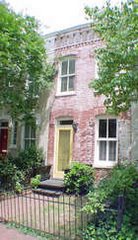
My relationship with Marilynne Robinson's art is more complicated. I've never met her, but one of my literary students who became a good friend gave me her 1981 novel Housekeeping two years ago, saying it was one of the best things he had ever read. I didn't read it right away because I was so busy, although he kept urging and asking if I'd gotten to it yet. Later that summer he perished as a passenger in a small plane accident -- he still lies buried within the fuselage under many feet of water, and the wreckage has not been found, although they know approximately where it is. In my sadness I picked up the novel to read it, and I was stunned when it opened with a similar accident, and continued that imagery throughout the novel: "The train, which was black and sleek and elegant, and was called the Fireball, had pulled more than halfway across the bridge when the engine nosed over toward the lake and then the rest of the train slid it into the water like a weasel sliding off a rock" (6). I never believed in premonitory visions -- even though I wrote a dissertation about dreams in 18th-century fiction -- until then. Now I don't know what to believe, but I do want to know more about the author.
Here's an excerpt from the Georgetown invitation:
Marilynne Robinson
Pulitzer Prize-Winning Author of "Gilead" and "Home"
&
Paul Elie
Author of "The Life You Save May Be Your Own: An American Pilgrimage"
Monday, April 6
2:00 p.m. - Riggs Library
(Reception immediately following)
Marilynne Robinson went to Brown University, graduating in 1966; she then enrolled in the graduate program in English at the University of Washington, where she started writing her first novel, Housekeeping (1981), which tells the story of two girls growing up in rural Idaho in the mid-1900s and is regarded by many as an American classic; it received the PEN/Hemingway award for best first novel and was nominated for the Pulitzer Prize. After the publication of Housekeeping, Robinson began writing essays and book reviews for Harper’s, Paris Review, and The New York Times Book Review. She also served as writer-in-residence and visiting professor at numerous colleges and universities, including the University of Kent in England, Amherst College, and the University of Massachusetts. Her second book, Mother Country: Britain, The Welfare State and Nuclear Pollution (1988), revealed the extensive environmental damage caused by the nuclear reprocessing plant at Sellafield, in the north of England; the book evolved from an essay that she wrote for Harper's Review and was a finalist for the National Book Award. A decade later, Robinson published a collection of essays entitled The Death of Adam: Essays on Modern Thought. Gilead, her second novel, published by Farrar, Straus and Giroux in November 2004, is an intimate tale of fathers and sons and the spiritual battles they face. The work won universal acclaim from critics and the 2005 Pulitzer Prize for Fiction. Her most-recent book, Home, published in 2008 - a companion piece to Gilead - is an elegant variation on the parable of the prodigal son's return.
Paul Elie, Senior Editor with Farrar, Straus and Giroux, LLC, New York, is the author of The Life You Save May Be Your Own: An American Pilgrimage (2003), a group portrait of Flannery O’Connor, Walker Percy, Thomas Merton, and Dorothy Day. The Life You Save May Be Your Own received the PEN/Martha Albrand Award for First Nonfiction, a Christopher Award, the Beliefnet Book of the Year award, and the annual awards in Christianity and Literature and in the Literature of the South given by the Modern Language Association; the book was a finalist for the National Book Critics Circle Award in biography. Mr. Elie’s article “The Year of Two Popes,” about the death of John Paul II and the election of Benedict XVI, appeared in February 2006 in The Atlantic, which published an earlier article of his, “In Search of a Pope,” about the run-up to the conclave. The magazine published his article about the contested legacy of Reinhold Niebuhr in its 150th anniversary issue last November. His writing has also appeared in Commonweal, The New Republic, and The New York Times, among other periodicals, and in several essay collections.


No comments:
Post a Comment